Our band of Victorian survivalists opened a portal to a swamp filled with vicious creatures, and then we went hunting. A magic spell created by one of our group pointed the way across the festering, waist-deep waters, which carried some unknown disease if you lingered in them for too long. Man-sized rats and frogs appeared at the fringes to slow our progress, but eventually, we found our prey: a fire-breathing beast called a Humbaba, big as a building, that lumbered across the landscape.
It took six of us, a whole lot of magic-infused rifle ammo, and a few deaths along the way, but before long, we toppled the beast. We skinned it and carried away its flesh to fill our stew pots and aid our crafting plans.
This is Nightingale, a survival game from developer Inflexion Games that goes into early access on February 20 on PC. We recently spent about six hours playing Nightingale in a preview event with developers, trying both the early game in a single-player experience and venturing out in co-op. It's a game about alternate dimensions: Rather than dropping you onto a massive map that spreads out over great distances and includes multiple locations and biomes, Nightingale is made up of smaller, procedurally generated "realms," each dominated by a single biome. You access these realms through magical portals, defining your destination by using special Tarot-like cards you can find or craft throughout your journey.
Where other games focus on generating a single map that you'll probably play on for most of your time with the game, whether you're alone or with friends, the idea behind Nightingale is that you have control of where you want to go and what will be waiting for you when you arrive. The cards you play at a portal define the biome of the new area, a major characteristic of what you'll find populating it (such as aggressive animals or NPCs you can talk to and trade with), and a minor aspect (like increasing the crafting supplies you find or setting the area's time of day). Each realm is procedurally generated depending on your parameters, allowing you to create adventures of exploration that let you try to achieve your goals. You can even use special machines to change the minor aspects of the realm while you're playing in it.
As is typical for the survival game genre, you have the usual progression up a crafting tech tree and the construction of a permanent settlement that can be your base of operations. Early on, you'll create your own personal Abeyance realm, where you can set up an "estate" to build up and expand over time. Inflexion mentioned that those realms are hosted on dedicated servers, so you can play together with friends and share an estate without requiring whoever "owns" that Abeyance realm to be online when you're playing.
Here, you'll do the usual tree-chopping and rock-gathering familiar to most survival games, building a new house to sleep in and constructing crafting tables that you can use to improve your tools and gear. There's a lot to do in your starter realm, and the idea of the portals is that, as you're hunting different materials, you'll travel to new realms to find what you need and bring that stuff back to further your development.
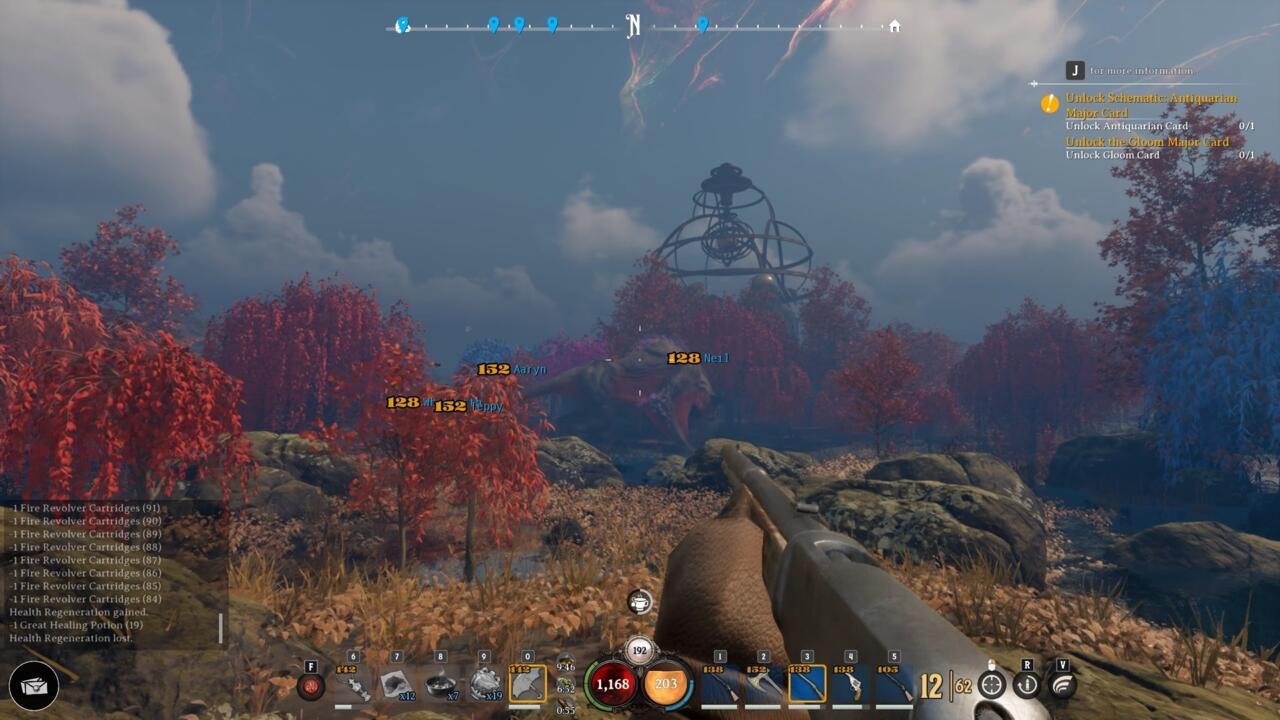
Generally, though, the survival elements of Nightingale seem pretty standard. Expect lots of trees to chop, boars to skin, and wolves to chase you around as you flee back to your house with darkness falling.
You also have to keep yourself well-fed and rested in order to stay alive. On that front, Nightingale mixes in a lot of common elements from other survival games. For example, eating anything will fill your hunger meter, but cooking and eating certain foods will increase your overall health or stamina for a set amount of time, which can be a major advantage.
Your overarching goal, however, is to find the city of Nightingale, and that endeavor leads to fun and exciting adventures through the realms. The underlying premise is of an alternate history that saw humanity discover and begin relations with the Fae--magical fairy folk, essentially, such as Puck from Shakespeare's "A Midsummer Night's Dream"--and incorporate magic into its pursuits alongside science.
People have been exploring the Fae's portals and the realms connected by them ever since, but at the start of the game, you find yourself stranded in those realms after fleeing a deadly fog that poured out of one such portal and engulfed the Earth in 1889. You and other refugees are hoping to find your way to Nightingale, where you can live in safety, but until then, you'll spend a lot of time trying not to die.
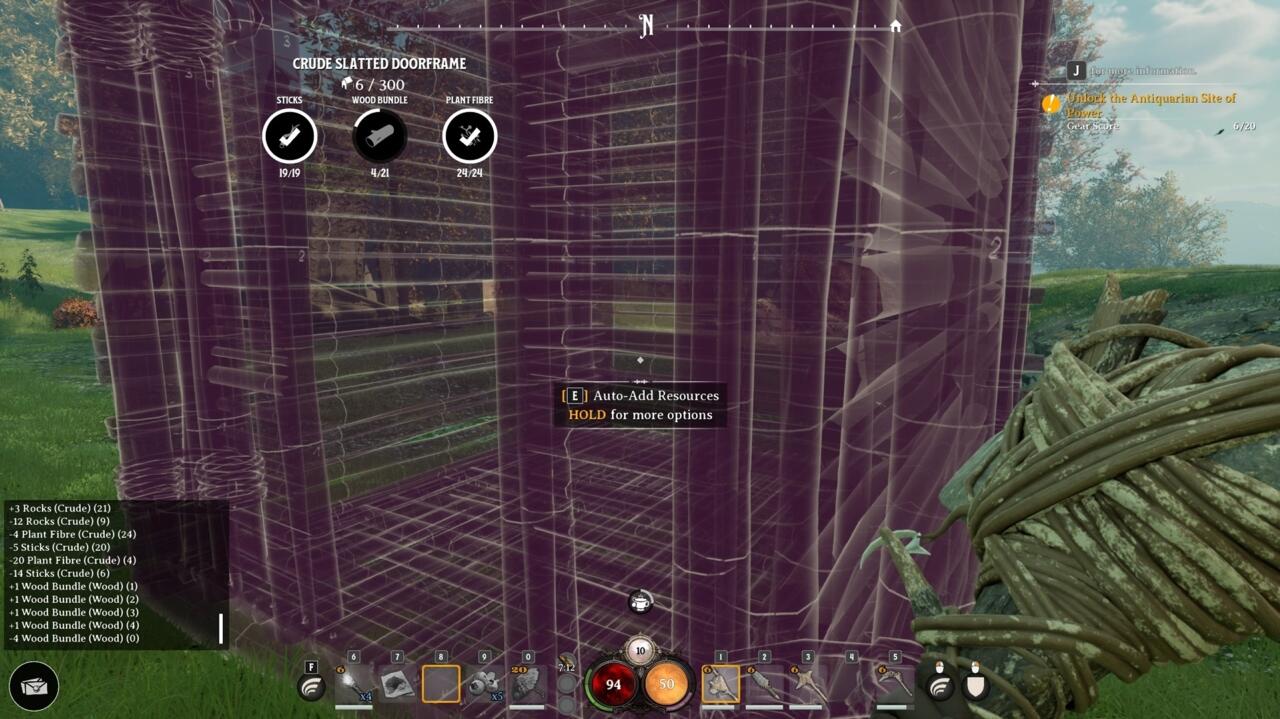
Neil Thompson, director of art and head of audio at Inflexion, said the Victorian setting was an outgrowth of the original portal-hopping concept. Thompson said he and CEO Aaryn Flynn were inspired by Susanna Clarke's novel Jonathan Strange and Mr. Norrell. They liked the book's conception of magic being a force that existed in the world, but one that was treated as an understandable academic pursuit that anyone could learn. The novel also deals with the idea that humanity pierces the "veil" between the human world and the fairy world and the consequences that result.
"When we started thinking about that, we were thinking, well, we don't want to put it in the same time period, which is the Napoleonic era, not just because we didn't want to copy word for word what they were doing, but also because it's not necessarily the most interesting time in terms of technology that could be used in a gaming experience. So weaponry is not that great--it's not much fun to reload a musket because it takes hours," Thompson explained. "But push it forward to the Victorian period--which is known for exploration and adventure, technological advancement, academic and artistic pursuits--and then it starts to get much more interesting because you can introduce machinery that can plausibly be used to interface with magical items. You can have guns that are six-shooters and Winchesters that are fast-loading. So for that more action-oriented player, you can get something a bit more contemporary. And just the whole Victorian period is so rich culturally and visually it just seemed to really [be a] natural fit."
Nightingale supports up to six people in cooperative play, and that section of the game was the highlight of our preview. Inflexion jumped us ahead in the progression to the mid-game, where you'd be after about 30 hours, Flynn told us. Your strength is determined by your gear, all of which carries a numerical score to let you know how strong you are and what threats you can handle.
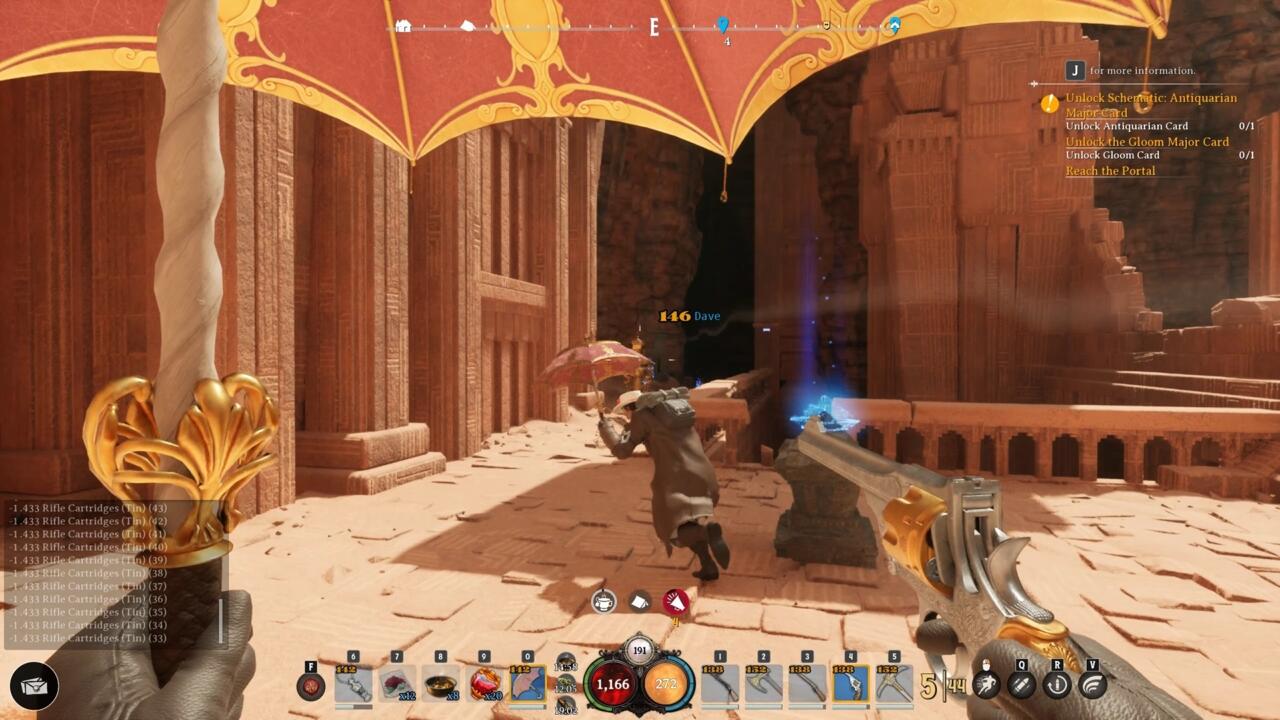
Where the early part of the game gives you the usual survival genre equipment, like knives and axes, advancing up the tech tree will eventually get you the ability to make rifles, revolvers, and shotguns. We also had ammo infused with fire, ice, electricity, and poison and could pull magical spells from our enchanted gear to cast during fights to increase defense or heal teammates. There's a fairly deep combat system in Nightingale that mixes up-close melee battles and first-person-shooter elements that felt punchy and satisfying throughout.
There also seems to be a lot of interesting stuff to find out in the realms and even on your home turf. There are Sites of Power, mini-dungeons you can fight through to claim new cards for your portal; I found one in a destroyed pirate ship atop a mountain, which led down into a spiraling cave and culminated in a boss fight against magical robots.
Our group also explored a desert world full of loot-filled vaults, each guarded by a handful of threatening creatures. What was most interesting, though, was that the vaults also featured some light puzzle-solving in order to advance through them. One puzzle had us activating switches in a specific order dictated by chimes that rang out through the space; when we hit the wrong one, a bunch of enemies spawned to punish us. In another, we had to find a hidden switch high above the area, which required some deft climbing to reach.
Nightingale also includes some light story elements and questing--Thompson said the game originally began its life as an MMORPG, and some of that DNA still exists within it. You'll hear a lot from Pan, who leads you through the tutorial, and Inflexion mentioned you'll meet a host of other familiar historical figures and literary characters, including Mr. Hyde and Victor Frankenstein. More characters and quests related to them will be added as time goes on, too.
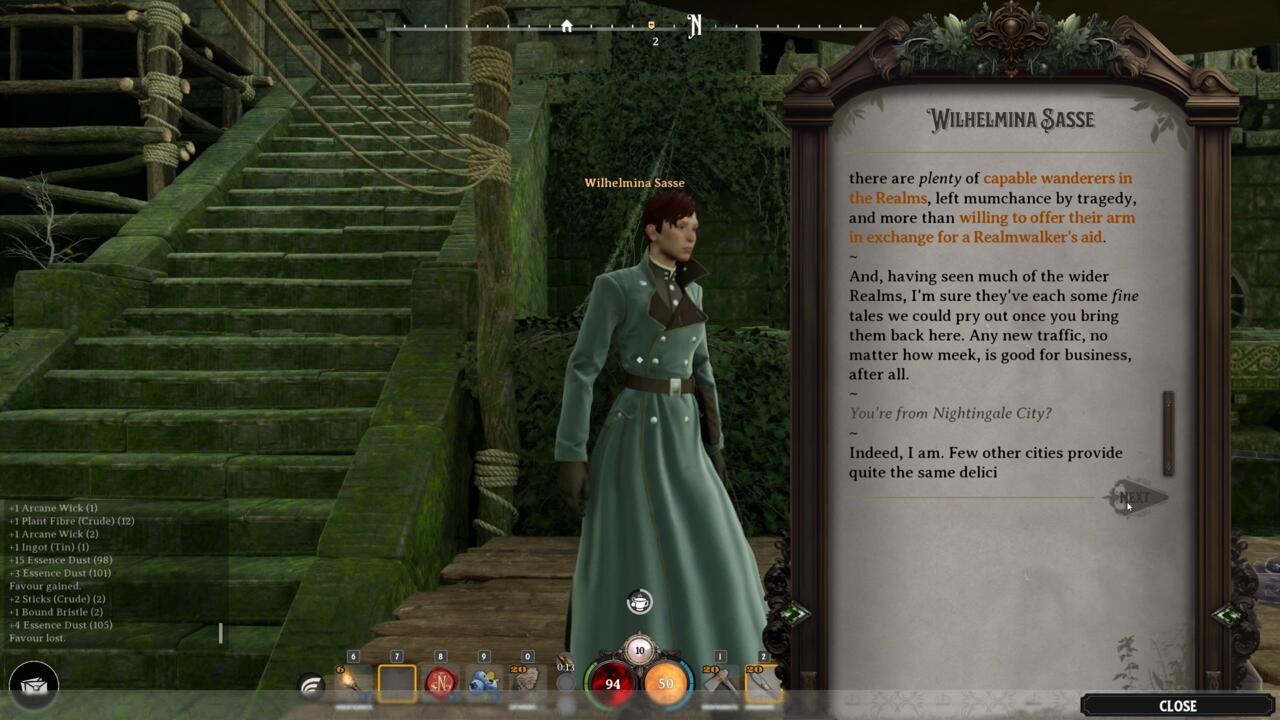
"Certainly as a survival crafting game, we're lighter on narrative--we're not trying to make a cinematic RPG or anything," Flynn said. "But we can't help but think there are cool characters out in these Realms that will offer players some fun and some interesting opportunities to adventure. And so those NPCs should be starting points for adventures, places to vault off and go. And we think they all blend into the world and they fit into the IP really well, and so we just want to bring more of those characters to life and into the world as the game evolves."
You'll eventually reach a social space dubbed The Watch, which is reminiscent of Destiny 2's Tower, where you can congregate with friends alongside vendors and NPCs. Flynn described the journey to the Watch as the game's first "act" and said you'll likely find characters there who will be fleshed out more over time. Flynn mentioned that Inflexion intends to add more beyond that, including "seasonal" stories later in Nightingale's life, so the Watch is likely to be a central point for characters to gather and those stories to start. But don't expect those quests to be expansive RPG-like narratives--more like starting points for your own experiences.
"Importantly for us, it's not that it's a narrative-led game where it has a start and an end," Thompson said. "It's more providing a really interesting premise and a depth of lore that maybe isn't as prevalent in traditional survival crafting games, so that players can play their own stories. And they can role-play their own adventures in the world that we've created."
Inflexion said they expect Nightingale to be in early access for around a year. It sounds like reaching the Watch and the end of the first act will be your primary goal in early access, with more content to come to the game later.
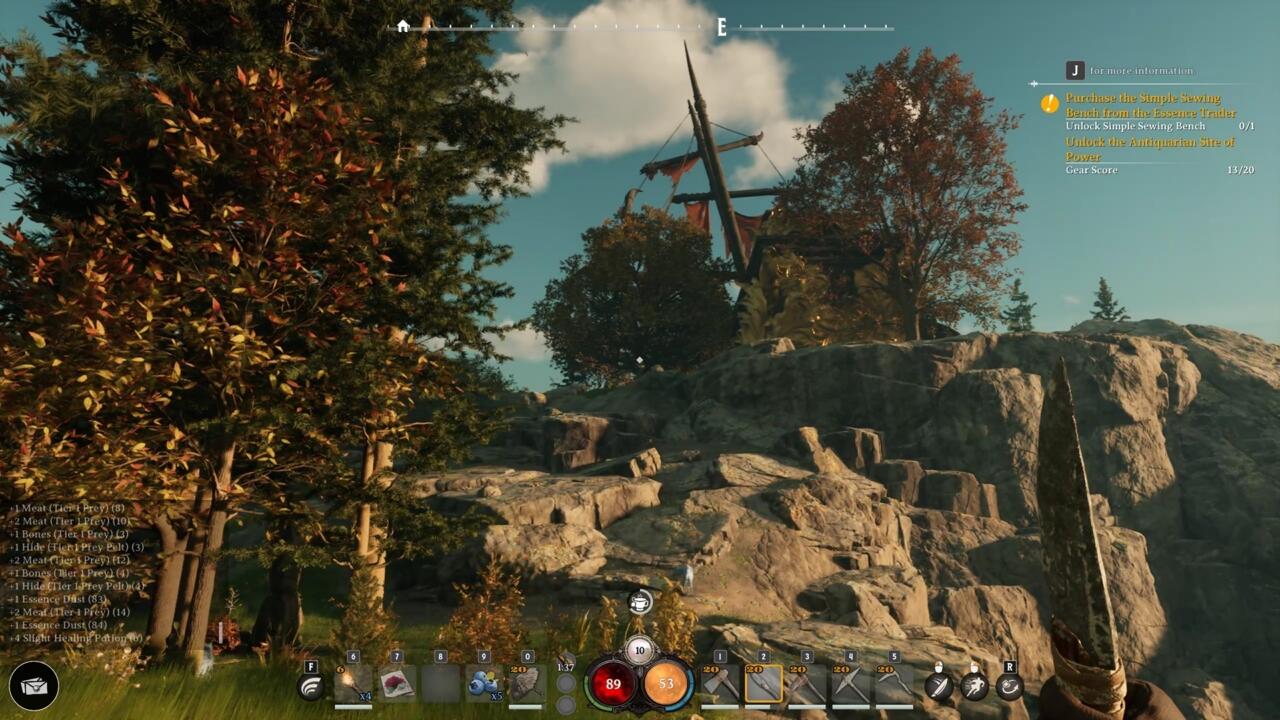
Head of production Leah Summers said that Inflexion's development has included working with players and conducting a lot of playtests to determine what resonates. The studio wants to use early access in a similar way to make sure it's driving Nightingale in the direction players want.
"As we go into early access, I think we see Nightingale as a really great stepping stone platform foundation to this awesome survival experience as a place," Summers said. "We all talked a lot about [how] its just enjoying building or going adventuring with friends or taking on big monsters or fishing, all that kind of good stuff. So I think the important part through early access is it gives us that opportunity to figure out, 'What is a great direction for Nightingale?' What are people loving about it?' And we're set up to be very flexible in terms of our development and our priorities to be responsive to that. And yeah, we just think Nightingale's a great foundation to start from with people."
As with our great hunt of that huge monster, it's the adventuring elements that seem like the most fun in Nightingale. Building up a Victorian estate that mixes Tudor and pagoda architecture is fine, but it's the weird things out in the realms that were compelling during our time in Nightingale. Elements like the destroyed pirate ship, the Industrial Revolution machines dropped into swamps or forests, and the hidden caves and ruins all give color to Nightingale.
If you enjoy the usual survival genre stuff, Nightingale has it, but where the game seems like it might stand apart from the pack is in venturing out to see what is waiting for you among the realms. I'm most fascinated to see what you can conjure up with your cards and what fearsome threats lie hidden. From the sounds of things, Inflexion Games only intends to expand the depth of Nightingale over time with more cards, more biomes, and more characters, so there should be plenty to discover.








